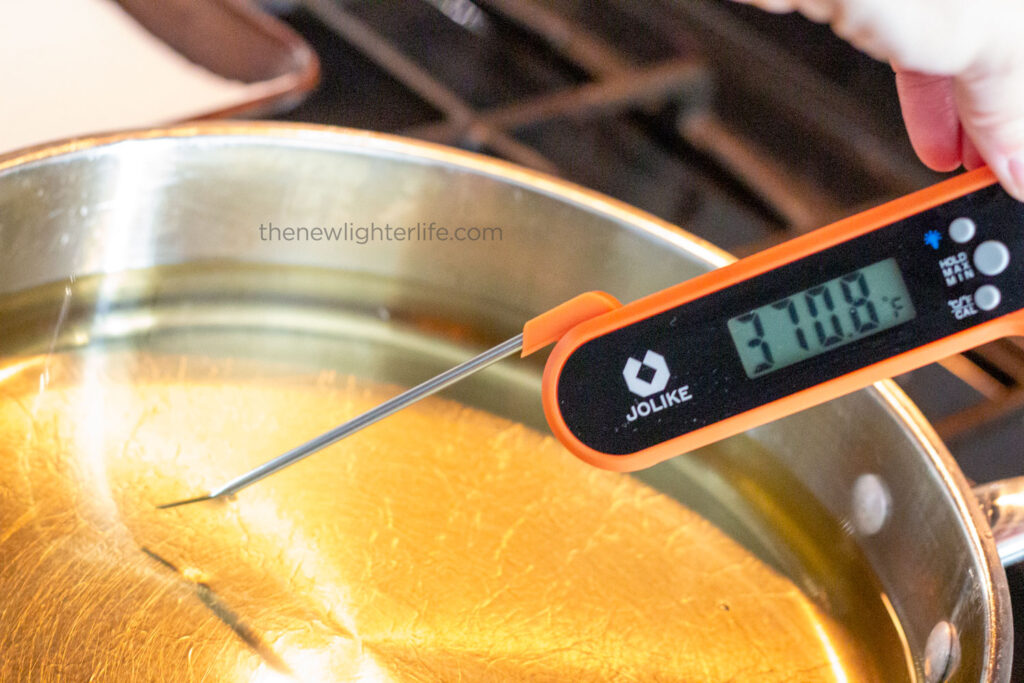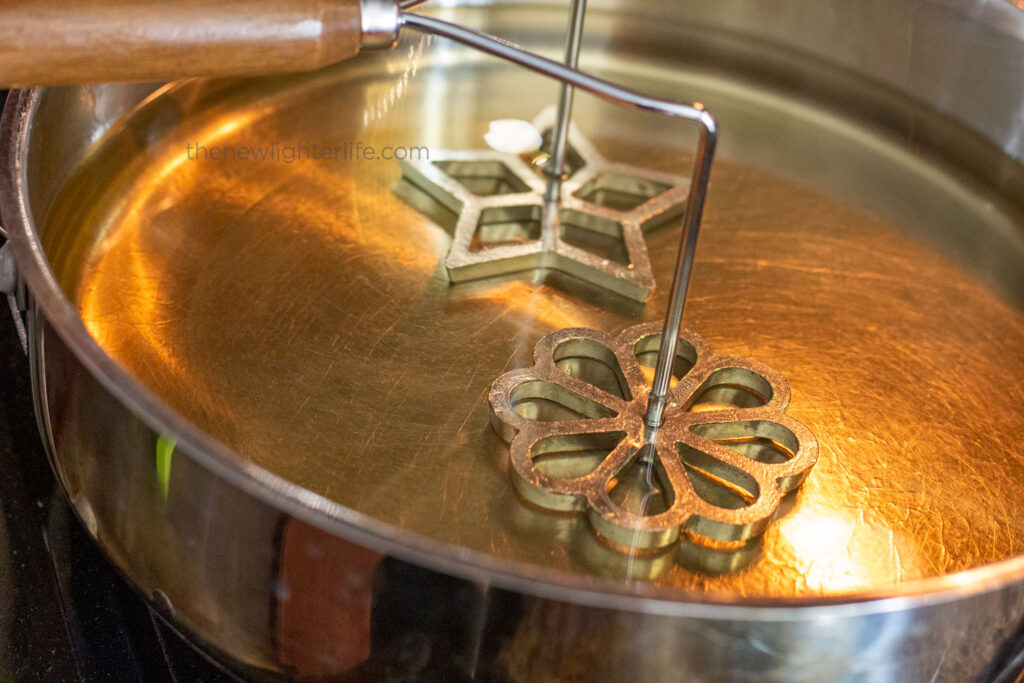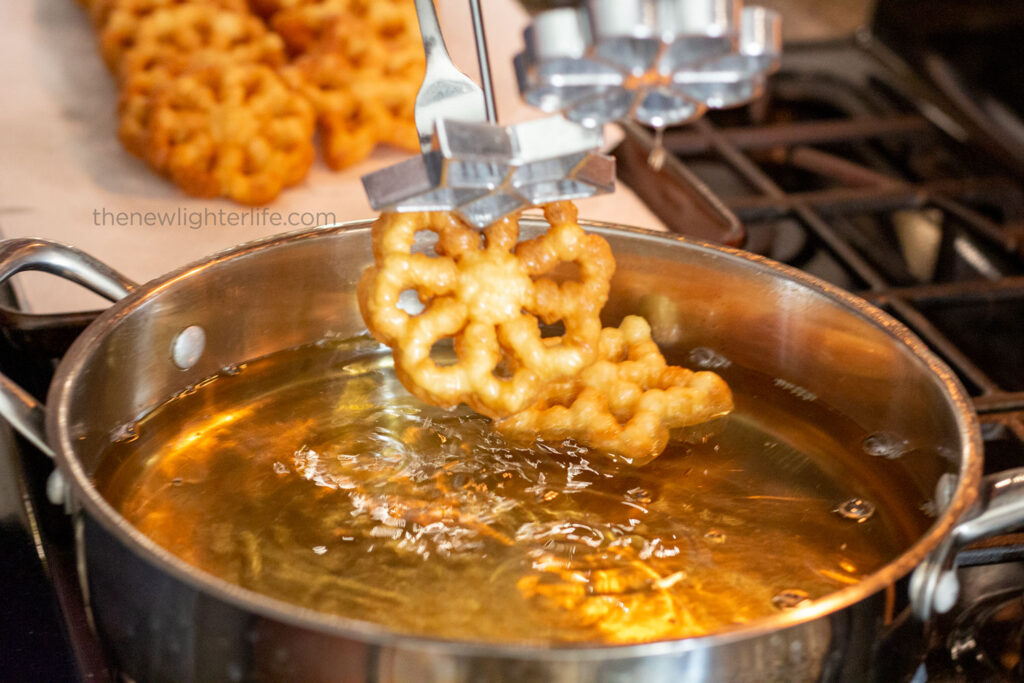Today, I’ve got my family’s recipe for rosette cookies. These cookies originate from Scandinavia and they have won over taste buds globally with their light, crispy texture, and beautiful shapes. A rosette cookie iron is the special tool behind these cookies’ unique shapes. Today we are going to dive into rosette cookies, including their history, how to make them with a rosette cookie iron, and expert tips for making the perfect rosette.
[ez-toc]
Background on Rosette Cookies
Before we get to making these cookies, I’d like to share a little background. We can (and should) thank Norway and Sweden for gifting us with these little delicious treats. You will see rosettes prominent around Christmastime. However, Indonesia and Mexico also have a variation of the rosette, known as “Buñuelos.”
Rosette cookies are unique in that they are more than just a sweet treat. Their intricate shapes and designs make them as beautiful to look at as they are delicious to eat. You can make rosettes from simple, commonly found ingredients such as flour, sugar, eggs, and milk.
Spoiler alert, rosettes are deep-fried PASTRIES rather than COOKIES. That said, please forgive me as I refer to them as cookies throughout this post. They have some similarities to other fried treats such as funnel cakes or churros. But their delicate, almost lacy appearance sets rosettes apart.
Our Family Tradition
Growing up, Thanksgiving and Christmas were the two holidays that more of our desserts were influenced by our Swedish heritage. In fact, about 38% of North Dakota’s population is of Scandinavian descent, with the predominant share of that demographic identifying as Norwegian (33%). Suffice it to say, growing up Christmastime included many Nordic treats (lefse & krumkake).
The Rosette Cookie Iron
The rosette cookie iron is an essential item when it comes to making these pastries. This tool is a piece of metal with a design on it, attached to a long handle. You will first dip the iron into hot oil to heat it, next dip the iron into a thin, pancake-like batter, and immediately submerge the battered iron into the hot oil. The batter adheres to the hot iron and fries quickly, creating a delicate, crisp cookie that retains the shape of the iron.
Rosette irons come in a variety of shapes, including stars, flowers, and snowflakes, and even more intricate designs like hearts and animals. This allows for a great deal of creativity when making these cookies, as you can choose different designs to suit different occasions or simply to add variety to your batch of cookies.
Before I go there though, to make rosettes you must have a special iron. There are several brands but I have the Norpro Rosette Iron, which is the best price. The prongs must be straight so you do not overbatter your rosette molds. To check this, place the iron flat on your counter and adjust the prongs as needed
Step-by-Step: How to Make Rosette Cookies with a Rosette Cookie Iron
There are a few key steps you need to follow closely to produce those perfect rosettes.
1. Preparing the Rosette Batter
The first step in making rosette cookies is preparing the batter. A mixture of eggs, sugar, flour, milk, salt, and vanilla extract for added flavor make up the batter. Mix these ingredients until they are smooth. The consistency of the batter should be similar to that of heavy cream, allowing it to adhere to the rosette iron easily.
NOTE: You will think you do not have enough batter but my recipe makes 25 rosettes.

2. Preparing for Frying
While the batter is resting in the refrigerator, you can prepare for the frying process. You will need a heavy pot or deep fryer filled with about two inches of vegetable oil or refined coconut oil. I use refined coconut oil for this which has a high smoke point and doesn’t have a coconut flavor. You can view other options of oil for frying, here. Heat your oil to between 370° and 375° Fahrenheit. Correct oil temperature is crucial for the success of your rosette cookies and you should check your temperature throughout the frying process.

3. Dipping the Iron in the Batter
Submerge the rosette cookie iron into the hot oil for a few seconds to heat it.

Carefully dip the hot iron into the cold batter, ensuring that the batter covers the mold but does not go over the top. If the batter covers the top of the mold, the fried cookie will be impossible to remove intact. If you dip your cookie iron into the batter too far, you will need to wash the iron before trying again.

4. Frying the Cookies
Immediately place the batter-coated iron into the hot oil for frying. The batter will begin to sizzle and fry, quickly turning into a golden, crisp cookie. If your cookie batter separates from the iron while cooking, simply press your iron down so that you maintain the rosette shape.

5. Removing the Cookie from the Iron
Remove the cookie from the oil once it is a golden brown color. Gently remove the cookie from the iron. You may use a fork or knife to gently loosen the cookie from the iron if it sticks.

6. Cooling and Dusting the Cookies
Place your removed cookie openside down on a paper towel-lined cookie rack to cool. If serving them within the day, dust the rosette with powdered sugar or dip them into a cinnamon-sugar mixture for a sweet finish.
Tips for Making Perfect Rosette Cookies with a Rosette Cookie Iron
While the process of making rosette cookies with a rosette cookie iron is straightforward, there are a few tips that can help ensure your cookies turn out perfectly every time.
- Maintain the Correct Oil Temperature: The oil temperature is crucial for the success of your rosette cookies. If the oil is too hot or too cold, the batter may not adhere to the rosette iron properly, or the cookies may not turn out as crisp as they should be. Always use a thermometer to monitor the oil temperature throughout the cooking process.
- Only Dip the Iron Partway into the Batter: When dipping the hot rosette iron into the batter, it’s important to only dip it partway. The batter should not cover the top of the mold, as this will cause the cookie to stick to the iron.
- Be Patient: Making rosette cookies takes time and patience. Don’t rush the process, and remember that practice makes perfect. If a cookie doesn’t turn out right, just move on to the next one.
- Store Properly for Maximum Freshness: Rosette cookies are best fresh, but you can also store them in an airtight container at room temperature for a few days. You may also store them in the freezer for up to 2 months if you need longer storage or live in a humid area. If you plan to freeze them, do so without the powdered sugar or cinnamon sugar topping. Once you defrost your rosettes, you can add the topping.
Serving Options for Rosette Cookies
If you are freezing your rosettes for later, wait to dust them with the confectioner’s sugar or dip them into the following cinnamon/sugar mixture.
- Cinnamon & Sugar – Mix granulated sugar and cinnamon (1/4 cup granulated sugar to 1 teaspoon cinnamon). Place the sugar mixture in a shallow bowl or on a plate and place the cooked rosette on top, wiggling it around to coat it.
- Confectioner’s Sugar – Simply dust the fried rosettes with confectioner’s sugar.
What Makes Rosettes Soggy?
Soggy rosettes are a huge disappointment and it is worth addressing this issue. A perfect rosette is crispy and crunchy. If you have a soggy rosette, there are two potential culprits to consider:
- Undercooked: You will need to fry your rosette longer so that it is crispy. The best measure of doneness is the color.
- Oil Temperature: The oil was not at the proper temperature when you fried your rosettes. Be sure to monitor temperature throughout the frying process.
- Humidity. If you live in a more humid climate it is especially important to store them in the freezer and remove them just before you plan to serve them.
Family Recipe for Rosette Cookies

The BEST Recipe for Rosette Recipe
Description
Ingredients
- 2 eggs
- 1 tbsp. granulated sugar
- ¼ tsp. salt
- 1 c. all-purpose flour
- 1 c. milk
- 1 tsp. vanilla extract
- oil for frying, refined coconut oil or flavorless oil
Cinnamon Sugar Topping
- ¼ c. granulated sugar
- 1 tsp. cinnamon
Instructions
- Prepare a cookie sheet by placing several layers of paper towels and a cooling rack on top of the cookie sheet.
- Combine the eggs, sugar, and salt in a medium bowl. Mix well.
- Add the flour and milk and beat until smooth.
- Heat the oil to 370° to 375°F.
- Place the ends of the rosette iron in the oil for a few seconds so it is nice and hot.
- Lift your iron out of the oil and let the oil drip off the iron.
- Immediately dip the hot iron in the batter. Make sure to not allow the batter to cover the top of the iron. Immediately place the battered iron into the hot oil.
- Fry rosettes until golden brown, anywhere from 30 to 50 seconds.
- Lift the fried rosette out of the oil.
- Turn the rosette, open ends down, onto the prepared cookie sheet. This will allow the oil to drain off easier.
- Ensure the iron is hot before redipping it into the batter and repeating the frying process.
- Store cooked rosettes in an airtight container at room temperature or in the refrigerator. You may freeze them for up to 2 months.
When Ready to Serve:
- Coat with the cinnamon/sugar mixture or lightly dust lightly with the confectioner's sugar.
Recipe Notes
Nutrition
Conclusion
Making rosette cookies with a rosette cookie iron is a wonderful way to celebrate the holiday season or to simply enjoy a delightful treat. While it may take some practice to master making these cookies, the end result is well worth the effort. Grab your rosette cookie iron and start making your own batch of these delightful treats today!
As an Amazon Associate, I earn from qualifying purchases at no extra cost to you. Thank you for your support!

2 thoughts on “The BEST Recipe for Rosette Cookies”